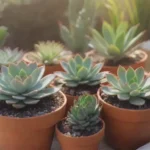
Resilient Succulents: Those That Excel in Temperature Changes

Introduction
Succulents have carved a niche in the hearts of plant enthusiasts and casual gardeners alike, celebrated for their striking appearances and varied shapes, sizes, and colors. While they are generally associated with arid climates, many species have adapted splendidly to endure fluctuating temperatures, making them ideal for different environments. Their remarkable resilience allows them to thrive not just in their native habitats but also in homes across the globe.
In this article, we will delve deeper into the world of resilient succulents, focusing on those that excel in temperature changes. From their unique adaptations to insights on how to care for them effectively, this article aims to equip you with extensive knowledge about these fascinating plants, ensuring you can enjoy their beauty and benefits in your own living spaces.
Understanding Succulents and Their Resilience
Succulents are a diverse group of plants characterized by their thickened, fleshy parts that store water. This adaptability enhances their ability to survive in arid conditions, but it is equally beneficial when they face varying environmental factors, particularly temperature. The ability of succulents to withstand temperature fluctuations is largely tied to their specific physiological adaptations that enable them to conserve water and maintain cell integrity.
During extreme temperature changes, succulents employ various strategies, such as go dormant or reduce their metabolism to conserve energy and water. Fluctuations in temperature can trigger these responses, allowing them to thrive even when environmental conditions are not ideal. Some succulents have specialized cell structures that allow them to quickly dissipate heat, minimizing the risk of overheating, while others can tolerate cold snaps by entering a state of dormancy until conditions improve.
It is important to note that not all succulents are created equal when it comes to temperature resilience. Understanding which species can handle significant temperature swings is pivotal for gardeners, especially for those living in areas with distinct seasonal changes.
Top Resilient Succulents for Temperature Changes
When considering succulents that excel at tolerating temperature changes, several standout species are worth mentioning. Each of these plants has unique characteristics and can thrive under different conditions, making them excellent choices for both novice and experienced gardeners.
Agave
Agave, often referred to as century plants, are native to arid regions of the Americas. These succulents can thrive in temperatures ranging from freezing to extremely hot climates, establishing themselves as one of the most resilient succulent families. Agaves possess a unique water-storing mechanism through their thick, fleshy leaves that can endure periods of drought, and their spiky leaf edges make them less appealing to herbivores.
 How to Monitor Temperature Levels in Your Succulent Garden
How to Monitor Temperature Levels in Your Succulent GardenOne species, Agave americana, can withstand temperatures as low as 10°F (-12°C) while flourishing in heat as high as 100°F (37°C). Their rosette shape allows them to capture and retain dew, while their ability to photosynthesize at night helps them reduce water loss during the hotter parts of the day. For gardeners in varied climates, Agave presents an excellent option that requires minimal care while offering striking architectural interest.
Sempervivum
Commonly known as hens and chicks, Sempervivum is another succulent that showcases incredible resilience in temperature changes. This genus comprises perennial plants native to the mountains of Europe, where they are often subjected to harsh climates that include cold winters and hot summers. Sempervivum are known for their ability to thrive in rocky, well-drained soils, which mimic their natural habitats.
One of the most remarkable features of Sempervivum is their ability to endure frost. Many species can withstand temperatures as low as -30°F (-34°C) without harm, making them prime candidates for regions with cold winters. Their rosette-shaped leaves form a tight cluster that helps protect them from harsh winds and reduce moisture loss. Additionally, their striking colors can change with the seasons, adding aesthetic value to any garden or indoor arrangement.
Echeveria
Echeveria is among the most popular succulent genera, with many species characterized by their beautiful leaf arrangements and colors. These rosette-forming succulents are famed for their remarkable resilience when exposed to temperature variations. While they primarily flourish in warm environments, certain species can adapt to cooler climates and still maintain their striking looks.
Echeveria elegans is one well-loved variety that demonstrates significant resilience to temperature changes. With the ability to tolerate temperatures as low as 20°F (-6°C), this succulent can thrive in regions with mild winters. They also possess the ability to go dormant during hot summer months, conserving water without losing their beautiful foliage. Moreover, Echeveria’s vibrant colors during cooler seasons make them a favorite for both indoor and outdoor settings.
Caring for Temperature-Resilient Succulents

Successfully nurturing resilient succulents involves understanding their basic requirements and providing conditions that mimic their natural habitats. By paying attention to the light, soil, and watering needs of these plants, you can ensure they flourish regardless of temperature fluctuations.
 Preparing Your Succulents for Summer: Temperature Considerations
Preparing Your Succulents for Summer: Temperature ConsiderationsLight Requirements
Light is one of the most critical factors influencing succulent growth. Most temperature-resilient succulents thrive in bright, indirect sunlight, but there are exceptions. For example, Agave varieties commonly prefer full sunlight, while Sempervivum can adapt to partial shade depending on the climate. When caring for your succulents, it’s essential to observe their responses to light fluctuations; elongated or pale foliage might indicate they are not receiving enough light.
To ensure your succulents receive adequate light, consider placing them near windows with south or west exposure. If growing indoors, rotating them occasionally can help optimize light exposure. If you notice your succulents stretching or losing their colors, it may be time to adjust their location or increase their exposure to natural light.
Watering Techniques
Overwatering is a common mistake when caring for succulents, especially in changing temperatures. Most resilient succulents have mechanisms that allow them to store water efficiently. It’s essential to allow the top inch of the soil to dry out between watering sessions. In cooler weather, succulents may need less frequent watering due to their slowed growth, while during hotter weather, they may need watering more regularly, but still be vigilant about moisture levels.
The best practice is to choose a well-draining soil mix specifically designed for succulents. This helps to prevent water from accumulating around the roots, reducing the risk of root rot. When watering, it’s better to do so deeply but less frequently, ensuring the roots can absorb the moisture they need without becoming waterlogged.
Environmental Adjustments
As your succulents face temperature changes, adjusting their environmental conditions can keep them thriving. For outdoor succulents, consider using protective measures such as frost cloths during chilly nights and providing shade in extreme heat. Additionally, incorporating materials like gravel or pebbles can help with drainage during heavy rains, ensuring the roots remain healthy.
For indoor succulents, establishing a consistent temperature range is vital. Avoid placing succulents near drafts or heating vents, as sudden temperature changes can stress the plants. Focusing on a stable environment allows the plants to adjust more smoothly to varying temperatures, maximizing their resilience and overall health.
Conclusion
In a world of rapidly changing climates, the appeal of resilient succulents is more significant than ever. They stand as an embodiment of strength and adaptability, managing to flourish in environments that would deter most other plants. With the knowledge of which succulents endure temperature variations and how to care for them effectively, you can cultivate a vibrant array of plants that not only beautify your space but also thrive under less-than-ideal conditions.
 Which Succulent Varieties Are Most Heat-Resistant?
Which Succulent Varieties Are Most Heat-Resistant?The journey toward growing resilient succulents is one filled with excitement and rewards. Each plant holds a story of survival, and as you nurture them, you become part of that journey. Your efforts can transform your garden or indoor spaces into stunning arrangements of colors, textures, and forms that reflect the beauty of nature's resilience.
Whether you're an experienced gardener or just starting, embracing resilient succulents empowers you to create a thriving environment. By taking the time to learn and adapt your approach, you can establish a lush sanctuary that showcases the incredible adaptability of these remarkable plants. Embrace the adventure—it’s time to let these resilient succulents thrive in your care!
If you want to read more articles similar to Resilient Succulents: Those That Excel in Temperature Changes, you can visit the Temperature Tolerance category.





You Must Read